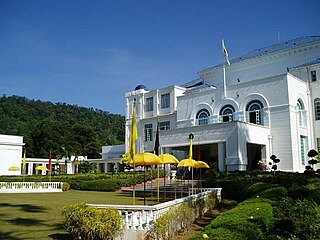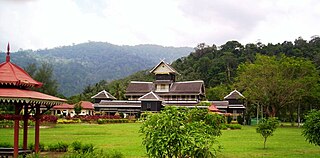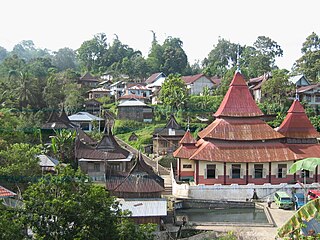
Minangkabau is an Austronesian language spoken by the Minangkabau of West Sumatra, the western part of Riau, South Aceh Regency, the northern part of Bengkulu and Jambi, also in several cities throughout Indonesia by migrated Minangkabau. The language is also a lingua franca along the western coastal region of the province of North Sumatra, and is even used in parts of Aceh, where the language is called Aneuk Jamee.

Negeri Sembilan is a state in Malaysia which lies on the western coast of Peninsular Malaysia. It borders Selangor on the north, Pahang in the east, and Malacca and Johor to the south.

An Undang is a ruling chief or territorial chief who still play an important role in the state of Negeri Sembilan, Malaysia. The name is believed to be derived from the Malay word undang-undang meaning "law".

Seri Menanti is a town, a mukim and a state assembly constituency in the Kuala Pilah District, in central Negeri Sembilan, Malaysia. It is the royal town of the state of Negeri Sembilan and houses the seat of the Yang Di-Pertuan Besar of Negeri Sembilan or Yamtuan Besar, the ruler of the state of Negeri Sembilan. The royal palace is known as "Istana Besar". Luak Tanah Mengandung is part of Seri Menanti. Seri Menanti is not to be confused with Kampong Seri Menanti, Muar, Johor.

Nilai is a town located in Seremban District, Negeri Sembilan, Malaysia, close to the border with Selangor. It is the northern suburb within the Seremban metropolitan area.

Johol is a town, a mukim and a state assembly constituency in Kuala Pilah District, Negeri Sembilan, Malaysia. It is roughly halfway between Tampin and Kuala Pilah, along Highway .

Yamtuan, also known officially as Yang di-Pertuan Besar and unofficially as Grand Ruler, is the royal title of the ruler of the Malaysian State of Negeri Sembilan. The Grand Ruler of Negeri Sembilan is elected by a council of ruling chiefs in the state, or the Undangs. This royal practice has been followed since 1773. The Yamtuan Besar is elected from among the four leading princes of Negeri Sembilan ; the Undangs themselves cannot stand for election and their choice of a ruler is limited to a male Muslim who is Malay and also a "lawfully begotten descendant of Raja Radin ibni Raja Lenggang", the 4th Yamtuan.

Tan Sri Dato' Seri Utama Dr. Rais bin Yatim is a Malaysian politician who has served as the 18th President of the Dewan Negara since September 2020. He was a Cabinet Minister in multiple federal governments from 1974 to 2013 and the 8th Menteri Besar of Negeri Sembilan from 1978 to 1982. He was the Member of Parliament (MP) for Jelebu from November 1999 to May 2013.

The Overseas Minangkabau is a demographic group of Minangkabau people of Minangkabau Highlands origin in West Sumatra, Indonesia who have settled in other parts of the world. Over half of the Minangkabau people can be considered overseas Minangkabaus. They make up the majority of the population of Negeri Sembilan and Pekanbaru. They also form a significant minority in the populations of Jakarta, Bandung, Medan, Batam, Surabaya and Palembang in Indonesia as well as Kuala Lumpur, Malacca, Penang, Singapore and Brunei Darussalam in the rest of the Malay world. Minangkabaus have also emigrated as skilled professionals and merchants to the Netherlands, United States, Saudi Arabia and Australia. The matrilineal culture and economic conditions in West Sumatra have made the Minangkabau people one of the most mobile ethnic group in Maritime Southeast Asia.

There are three palaces in Seri Menanti, Negeri Sembilan.
The flag and the coat of arms of Negeri Sembilan are state symbols of Negeri Sembilan, Malaysia. The symbols are predominantly depicted in red, black and yellow, traditional colours of the Minangkabau people who are the original settlers in the present-day state. Also recognised in the symbols are the political history of Negeri Sembilan, its ruler, and the state's past relationship with the British Empire.

The Menteri Besar of Negeri Sembilan or First Minister of Negeri Sembilan is the head of government in the Malaysian state of Negeri Sembilan. According to the convention, the Menteri Besar is the leader of the majority party or largest coalition party of the Negeri Sembilan State Legislative Assembly.
Negeri Sembilan Malay is an Austronesian language spoken mainly in the Malaysian state of Negeri Sembilan and in northern Malacca in Alor Gajah. The language is spoken by the descendants of Minangkabau settlers from Sumatra, who have migrated to Negeri Sembilan since as early as the 14th century. It is often considered a variant or dialect of the Minangkabau language; lexical and phonological studies, however, indicate that it is more closely related to Standard Malay than it is to Minangkabau.

Seremban is a city in the Seremban District and the capital of the state of Negeri Sembilan in Peninsular Malaysia. The city's administration is run by the Seremban City Council. Seremban gained its city status on 20 January 2020.
Simpang Durian is a small town in Jelebu, Negeri Sembilan, Malaysia. It is situated about 10 km from the Pahang border and about 130 km from Kuala Lumpur. Simpang Durian is also a popular stopover destination for super bikers from Singapore and southern states of West Malaysia to rest and refuel before proceeding to Genting Highlands.
The Indonesian Malaysians, also known as Anak Dagang are Malaysian citizens of Indonesian ancestry. Today, there are many Malaysian Malays who have lineage from the Indonesian archipelago and have played an important role in the history and contributed to the development of Malaysia, they have been assimilated with other Malay communities and are grouped as part of the foreign Malays or anak dagang in terms of race. The Malaysian census does not categorize ethnic groups from the Indonesian archipelago as a separate ethnic group, but rather as Malays. In Malaysia, the definition of Malay is a person who can speak Malay, is Muslim, and follows Malay traditions and customs, even non-natives who marry Malays and embrace Islam are also accepted as Malays. In Malaysia there is a political trend of trying to put all ethnic groups who speak Malay and happen to be Muslim under one banner - Malay. This is not the case in Indonesia where all ethnic groups have their own cultural identities that are recognized and respected by the government.

A nagari is a semi-autonomous Minangkabau people regional administrative unit in West Sumatra, Indonesia.
The following is the family tree of the Malay monarchs of Negeri Sembilan, from the establishment of the chieftaincy in 1778 until present day. The monarch is styled Yang di-Pertuan Besar or shortened as Yamtuan Besar. The first three monarchs namely, Melewar, Hitam and Lenggang were hailed from Pagaruyung in Sumatra, and were invited to rule the confederacy of Minangkabau Luaks of Negeri Sembilan. The accession of the locally-born Radin marked the end of the practice of inviting princes from Pagaruyung.
Minangkabau clans or suku are traditional kinship groups sharing a common surname and heritage and existing in a lineage based society prior to the fifth century. These clans are descended matrilineally which means clans are descended based on the female line.













